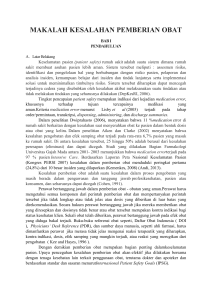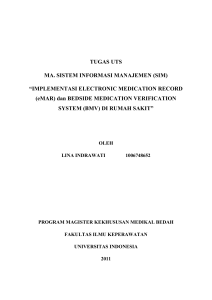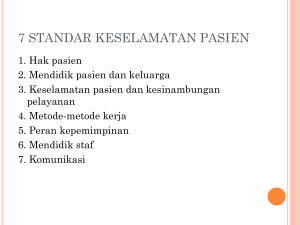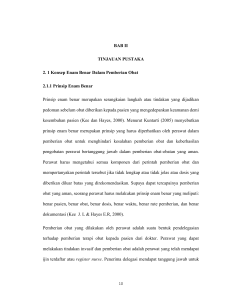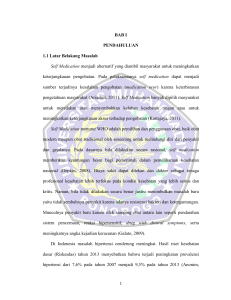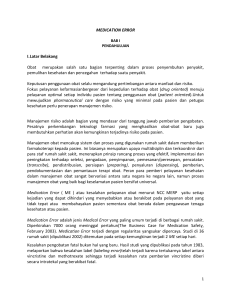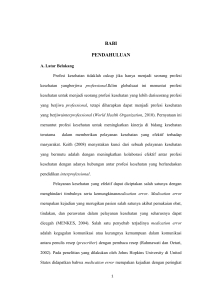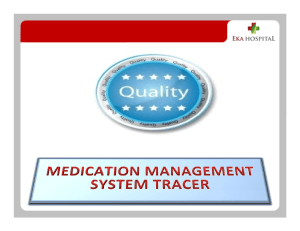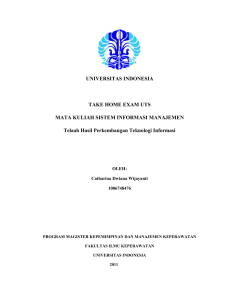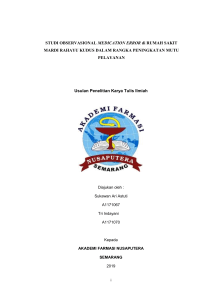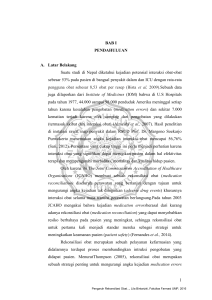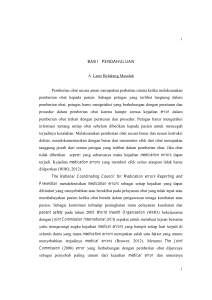ii ABSTRAK Pengobatan sendiri didefinisikan sebagai pemilihan
advertisement
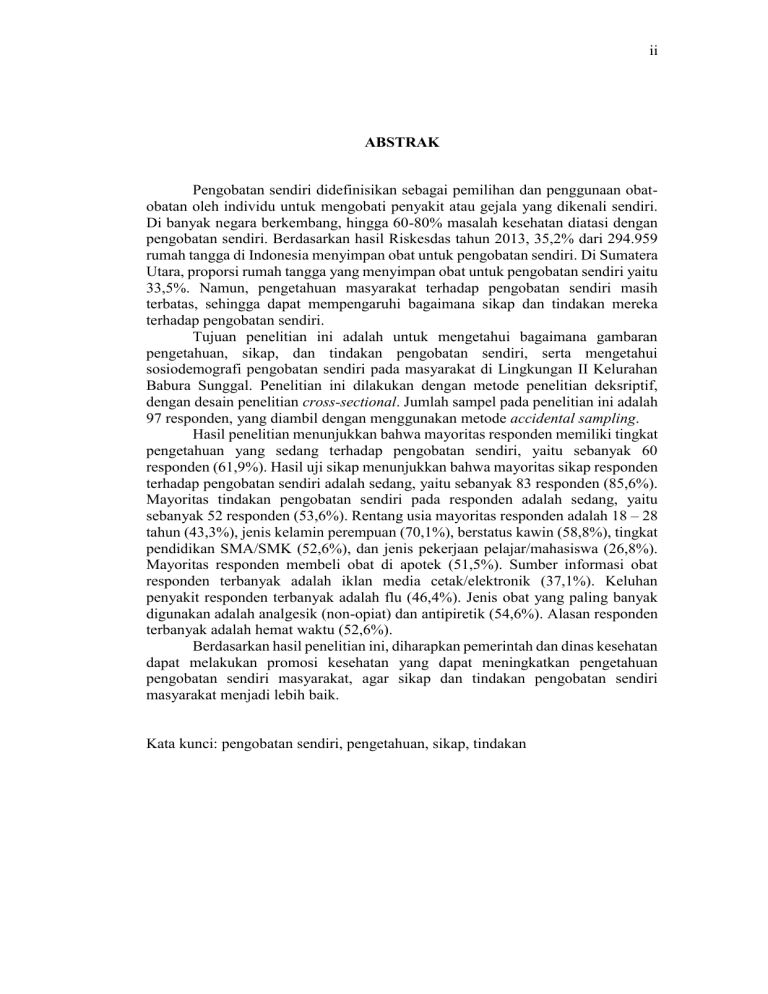
ii ABSTRAK Pengobatan sendiri didefinisikan sebagai pemilihan dan penggunaan obatobatan oleh individu untuk mengobati penyakit atau gejala yang dikenali sendiri. Di banyak negara berkembang, hingga 60-80% masalah kesehatan diatasi dengan pengobatan sendiri. Berdasarkan hasil Riskesdas tahun 2013, 35,2% dari 294.959 rumah tangga di Indonesia menyimpan obat untuk pengobatan sendiri. Di Sumatera Utara, proporsi rumah tangga yang menyimpan obat untuk pengobatan sendiri yaitu 33,5%. Namun, pengetahuan masyarakat terhadap pengobatan sendiri masih terbatas, sehingga dapat mempengaruhi bagaimana sikap dan tindakan mereka terhadap pengobatan sendiri. Tujuan penelitian ini adalah untuk mengetahui bagaimana gambaran pengetahuan, sikap, dan tindakan pengobatan sendiri, serta mengetahui sosiodemografi pengobatan sendiri pada masyarakat di Lingkungan II Kelurahan Babura Sunggal. Penelitian ini dilakukan dengan metode penelitian deksriptif, dengan desain penelitian cross-sectional. Jumlah sampel pada penelitian ini adalah 97 responden, yang diambil dengan menggunakan metode accidental sampling. Hasil penelitian menunjukkan bahwa mayoritas responden memiliki tingkat pengetahuan yang sedang terhadap pengobatan sendiri, yaitu sebanyak 60 responden (61,9%). Hasil uji sikap menunjukkan bahwa mayoritas sikap responden terhadap pengobatan sendiri adalah sedang, yaitu sebanyak 83 responden (85,6%). Mayoritas tindakan pengobatan sendiri pada responden adalah sedang, yaitu sebanyak 52 responden (53,6%). Rentang usia mayoritas responden adalah 18 – 28 tahun (43,3%), jenis kelamin perempuan (70,1%), berstatus kawin (58,8%), tingkat pendidikan SMA/SMK (52,6%), dan jenis pekerjaan pelajar/mahasiswa (26,8%). Mayoritas responden membeli obat di apotek (51,5%). Sumber informasi obat responden terbanyak adalah iklan media cetak/elektronik (37,1%). Keluhan penyakit responden terbanyak adalah flu (46,4%). Jenis obat yang paling banyak digunakan adalah analgesik (non-opiat) dan antipiretik (54,6%). Alasan responden terbanyak adalah hemat waktu (52,6%). Berdasarkan hasil penelitian ini, diharapkan pemerintah dan dinas kesehatan dapat melakukan promosi kesehatan yang dapat meningkatkan pengetahuan pengobatan sendiri masyarakat, agar sikap dan tindakan pengobatan sendiri masyarakat menjadi lebih baik. Kata kunci: pengobatan sendiri, pengetahuan, sikap, tindakan iii ABSTRACT Self medication is defined as the selection and use of medicines by individuals to treat self-recognized illnesses or symptoms. In many developing countries, up to 60-80% of health problems are self-medicated. Based on Riskesdas 2013, 35,2% of 294.959 households in Indonesia store medicines for self medication. In North Sumatra, the proportion of households which store medicines for self medication is 33,5%. However, knowledge of the society of self medication is still limited, which may affect how attitudes and their actions towards self medication. The purpose of this study was to determine the level of knowledge, attitudes, and practices of self medication, and to know the self medication sociodemographic among the community of Lingkungan II Babura Sunggal. This study was conducted using descriptive study, with a cross-sectional study design. The number of the samples in this study were 97 respondents, that obtained by using accidental sampling method. The results showed that the majority of respondents have a moderate level of knowledge in self medication, which was 60 respondents (61,9%). The results for attitude in self medication showed that the majority of respondents’ attitude was moderate, which was 83 respondents (85,6%). The majority of practice in self medication was moderate, which was 52 respondents (53,6%). The majority of range of respondents’ age was 18 – 28 years (43,3%), the gender majority was woman (70,1%), the marital status was married (58,8%), the educational level was SMA/SMK (52,6%), and the occupation was student/college student (26,8%). The majority of respondents bought medicines from pharmacy (51.5%). The most common source of medicine information was from advertisement (37,1%). The most common symptom of respondents was flu (46,4%). The most common type of drug that was used was analgesics (non-opiat) and antipyretics (54,6%). The most common reason was time saving (52,6%). Based on this study, it is expected that government and health official could conduct health promotions that could improve the knowledge of society in self medication, thus the attitude and practice in self medication of society would be better. Keywords: self medication, knowledge, attitude, practice
